Click here to read all of the posts in the “Where have I been?” series (if you haven’t you should probably start from the beginning, before you read on)
Part IV: Buenos Aires, Argentina to Puerto Iguazu, Argentina to Foz do Iguascu, Brazil
I barely doze on the seven-hour flight to Buenos Aires, Argentina, but somehow I awaken as the sun rises over the green – so green! – infinity that surrounds the city. We step off the plane onto Argentinian soil. Groggy and disoriented – what time is it? – we find a bus that takes us… somewhere? Downtown.
We call for a cab who can drive us the remainder of the way to our hostel. We load ourselves and our packs into the tiny car as he drives us all over the city – in an attempt to either sincerely help us find a currency exchange house or rack up his taxi-meter. Or both.
By the time we arrive, I’m too tired to argue about the exorbitant ransom of time and money that we’ve been forced to surrender.
Buenos Aires is hot. Even at 9am, I barely notice the exhaust spewing from the 12 billion cars, trucks, and buses as the ambient temperature approaches 90F and the air is so humid that I expect to see a school of mackerel swimming down the crowded boulevard. The hostel has air conditioning.
The upcoming three and a half weeks are to be a whirlwind of cities and mountains, flights and bus rides, hikes and hostels, penguins and toucans. We’ll begin and end our journey in this “Paris of South America,” and in between we’ll cover some 7,000 miles from the steamy jungle of the north to the frigid “end of the world” in the (very far) South.
We quickly learn that Buenos Aires – and Argentina, in general – runs on a wanna-be Europe, late-night schedule. The woman at our hostel laughs at us when we ask about getting dinner around 6pm.
“Here, things open at 8:30,” she says. “Maybe 8:00. Some.”
We thank her and find a cheap pizza place down the street. Our next flight leaves at 5:30 the next morning.
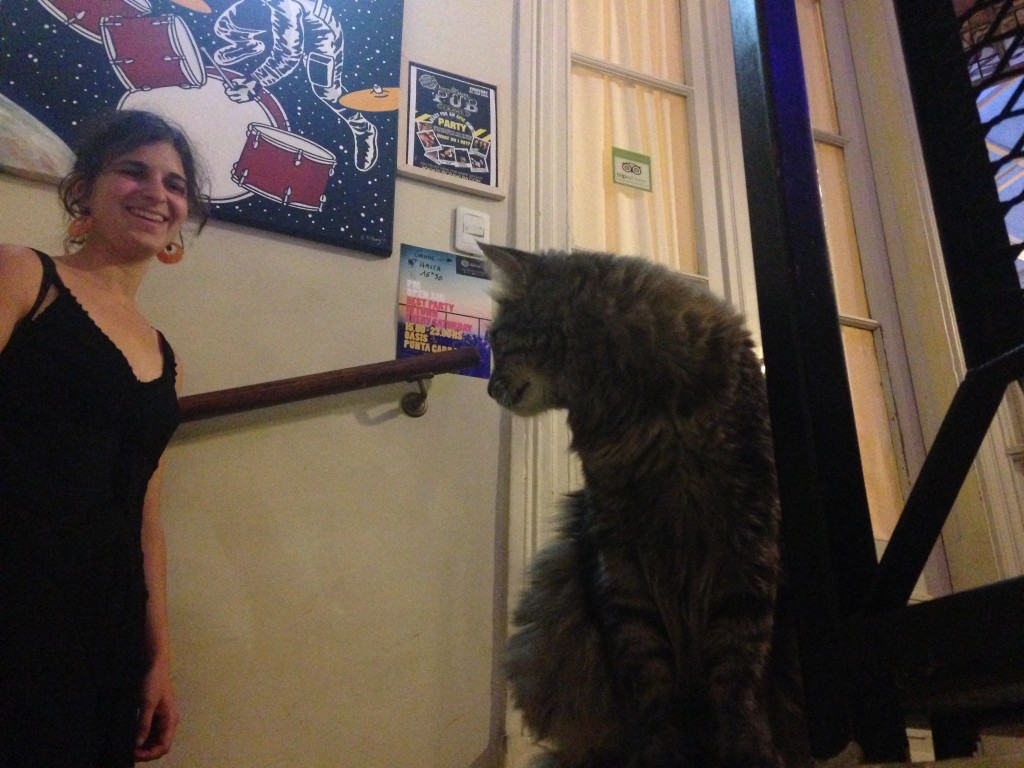
Mariana and the Buenos Aires hostel cat (friendly, snuggly)
Puerto Iguazu is even greener than Buenos Aires. And even hotter. And more humid!
The airport is more like a giant lodge. We stand outside and wait for the bus that’ll take us into town and I keep my eyes open for monkeys and macaws and velociraptors. Nothing would surprise me.
On the ride, our bus-mates are similarly glued to the windows, hoping for a glimpse of something… exotic. But we just drive down a four lane highway and I wonder how much effort it must take to keep the life that flourishes everywhere from encroaching onto the pavement. How quickly any memory of our occupying this space would disappear without our constant maintenance.
The town of Puerto Iguazu, located in the north eastern corner of Argentina, has sprung up in response to the enormous influx of people from all over the world who take trains and airplanes and buses over no short distance to see the Iguazu Falls.
The Falls are really a monstrous congregation of hundreds of waterfalls which stretch nearly 3km wide along the borders of Argentina and Brazil deep in the jungle. (Eleanor Roosevelt allegedly remarked “Poor Niagara!” upon her first glimpse.) What used to be an inaccessible, remote section of forest has recently become a major destination for tourism and – in response – a populous town for Brazilians and Argentinians who want to make a buck off those tourists.
What’s left is an odd combination of services aimed at wealthy outsiders (lodging ranging from five-star resorts to budget hostels, expensive restaurants, and souvenir shops) and a sub-economy of schools and stores that have sprung up for the many local people who now live in Puerto Iguazu (to serve the food and drive the buses and sell tour packages to wealthy groups of Europeans).
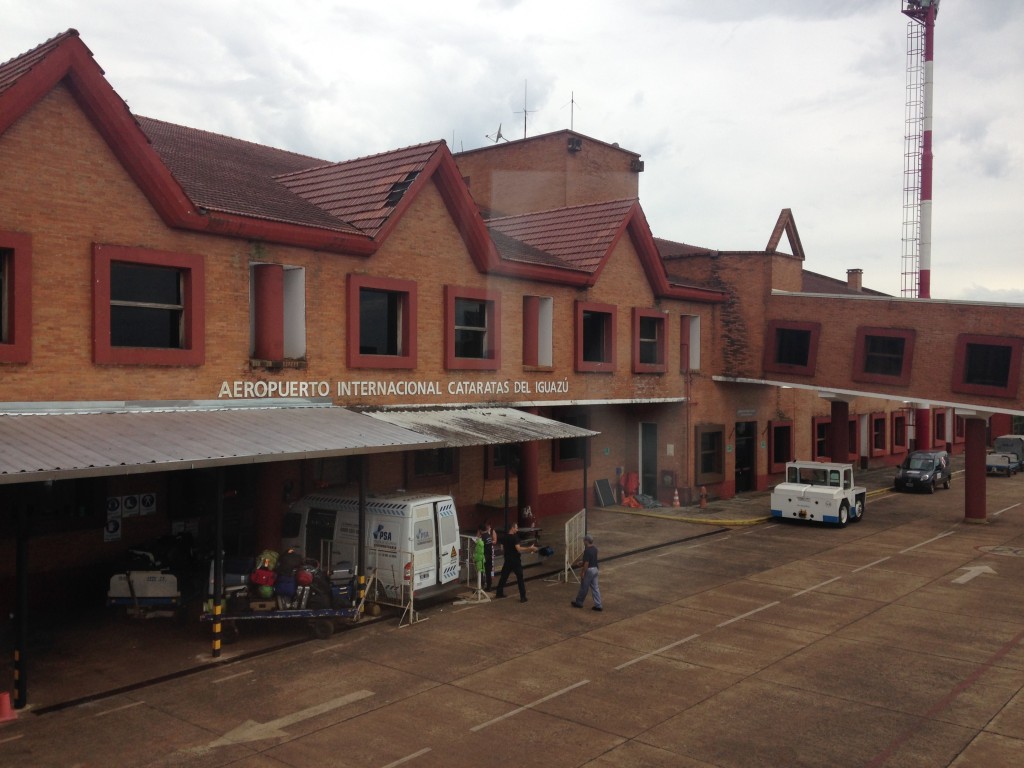
Welcome to Iguazu!
Despite having woken up 831 miles to the south, our (mostly) smooth and (entirely) too early morning of travel finds us in our new room in our new locale by 9am. Clouds are rolling in as we board the bus and roll out of town and back into Jurassic Park.
Somehow, we end up freezing. The clouds turn to a steady rain that lasts the whole day and the temperature plummets to the point that the rain is no longer a welcome, cool spray, but a shivering blast. I’m a cat that fell into the sink.
But Ms. Roosevelt was right. Even with the cold and rain, we’re blown away by the sheer power of it all. The incomprehensible volume of water moving from up here to down there.
And there are the critters and sounds of the jungle – the coatis and parrots and monkeys (yes, monkeys!) that scamper about, completely oblivious to how excited the humans are to see them. What a day!
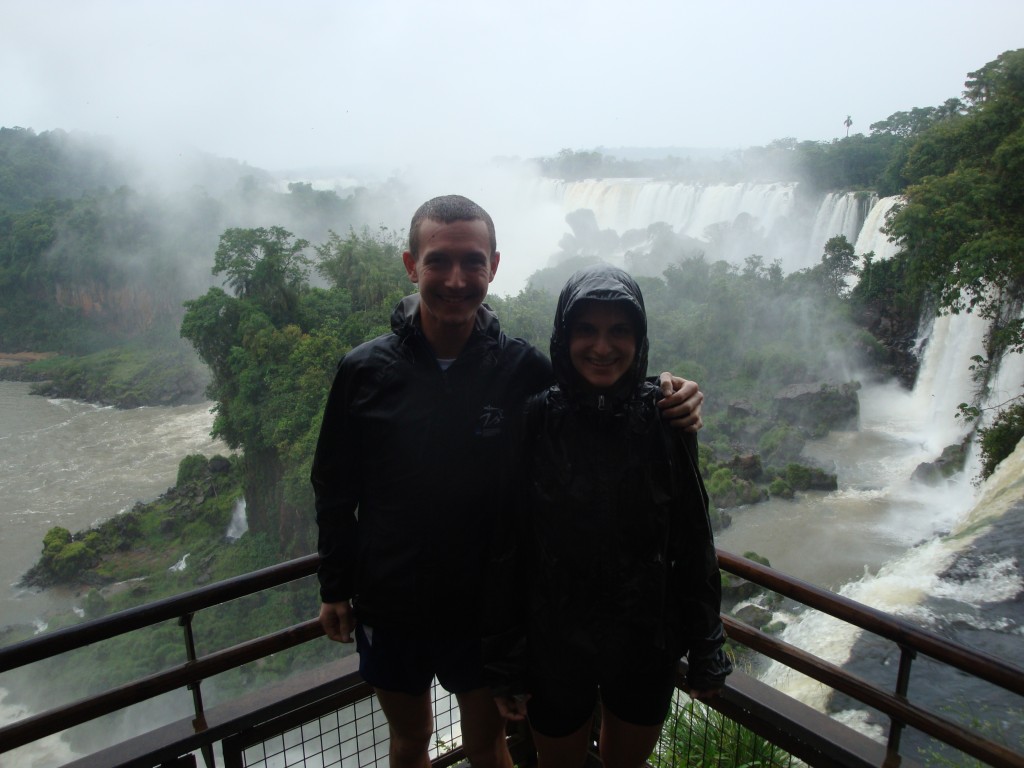
Drowned cats, but excited nonetheless.
The next morning, I’m already sweating by the end of the short walk between our room in the hostel and the covered patio where breakfast is served. The resident cats (skittish, not friendly) are sprawled out on the grass as the sun dries them (and everything) out. This is more like it.
We quickly pack up and walk four blocks to the small town-center, where we find what we’re looking for: “Cambio, cambio!” A young man yells out the words that every tourist in South America can understand. It’s time to change money.
We buy about $50 worth of Brazilian Reales for what will be less than 12 hours across the River.
See, Iguazu Falls lie right on the border of the two countries, with each offering its own unique opportunities for exploring and viewing. So, like many who’d come before us, we decided to take a quick hop across the border into Brazil to experience the Falls from the other side.
With our new Reales in hand, a small day-pack with our cameras and extra clothes (we’ve learned from the day before), we catch the bus which will take us across the international bridge, out of Argentina, and into Brazil.
On the other side, we quickly realize that the bus has not taken us where we expect (where the man in our hostel had assured us it would), and we step off onto a street we do not know in a country with a language we cannot speak. In Spanish (which, surprisingly, no one seems to speak and barely anyone understands), we try to ask how to get to the Falls or just the road that goes to the falls; that’d be a good start. A few helpful people point us in the right direction and we’re walking along the side of the highway. I worry that the pavement might melt the soles of my shoes.
As always, we find our way and arrive at the giant entrance to the National Park – Mother Nature’s Disneyland, where a double-decker bus takes us (and one-hundred of our closest friends) through the jungle along a paved road into the park.
We can hear the water before we can see it. Walking down from the main plaza provides panorama after panorama. The blue skies and sun make the constant mist so much more pleasant today as we follow a trail along the edge of a cliff overlooking the falls. There are rainbows. And butterflies. Finally, we come to the end of the trail – a series of cat-walks that edge out over the water.
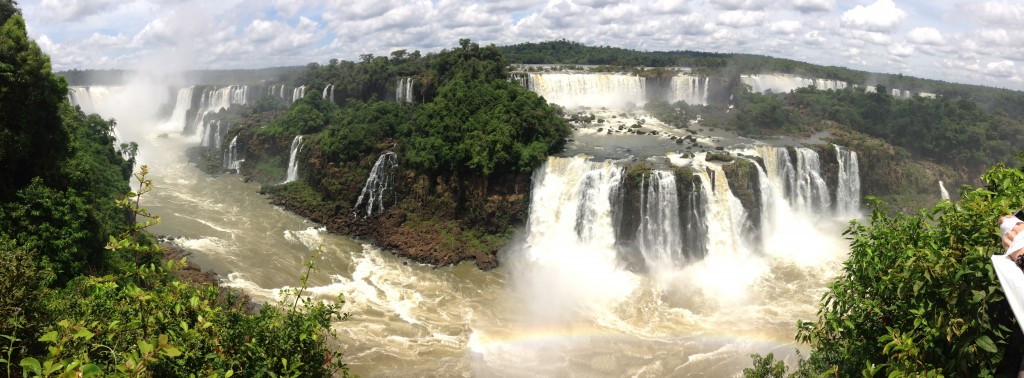
The Brazilian (sunny) side of the falls, complete with rainbows and butterflies.
That noise and awe of the power of nature are – again – hard to grasp in the moment and even harder to put into words now.
But it is something. We sit and enjoy an (extremely overpriced) ice cream cone and soak in the hot sun – retroactively cooling our soaked bodies of yesterday. We pass another gaggle of coatis (not friendly – do not feed) before heading out of the woods.
Across the street, there’s a famous Parque do Aves (bird park) which offers ample opportunities for up-close encounters with all types of avian friends – toucans, parrots, macaws, flamingos, you name it.
By the time our bird encounter is finished, it’s almost time to catch the last bus back to Argentina. We grab a quick empanada (always important to sample the local cuisine) and catch a ride back to the main bus route, where we cross back to Argentina (finally able to communicate again!), and head back to our room.
That evening, we stroll down to a point just outside of town where one can see the confluence of two major rivers, forming a “Y”, a few hundred feet below. Standing in Argentina, we can see across to Brazil in one direction and Paraguay in the other.
“We were just there,” I think. Looking at the forest just a stone’s throw from where we’re standing. It’s no different than any other river I’ve stared across and this makes its border demarcation seem that much more arbitrary.
We enjoy a last meal as the sun simultaneously sets over all three countries. In the morning, we’ll follow the pattern of so many others and head back to the airport, leaving the jungle and the coatis and the money-changers (at least, these money-changers) behind. And, it’s sad, but we probably won’t be back.
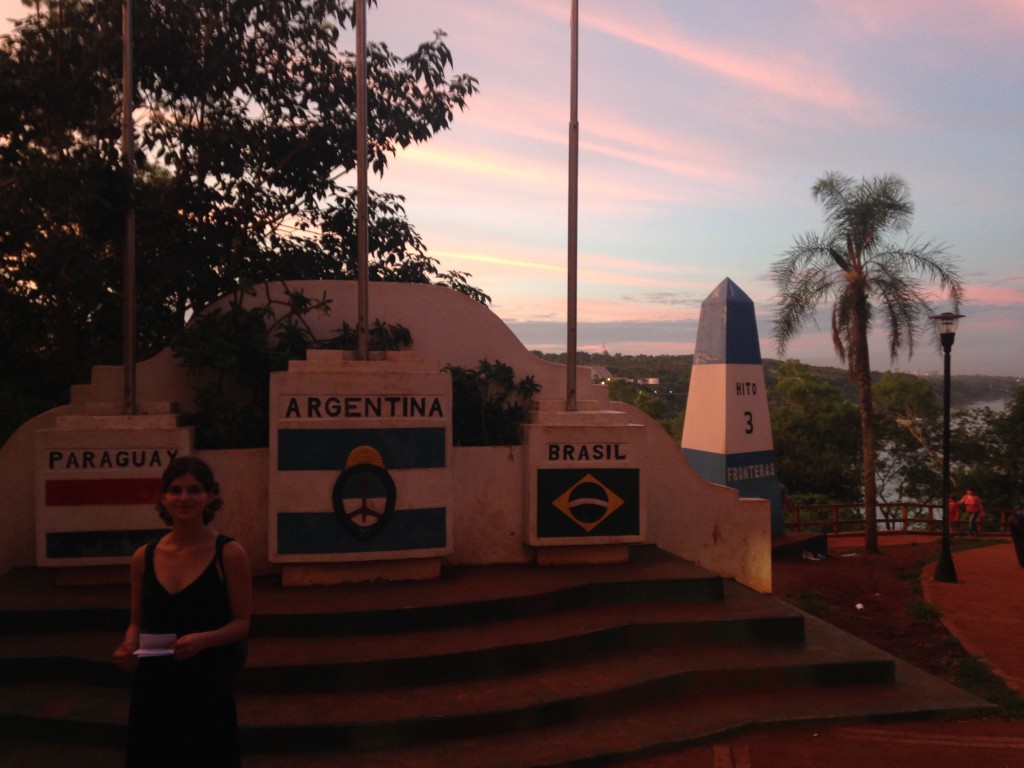
Sunset over three countries

Leave A Comment